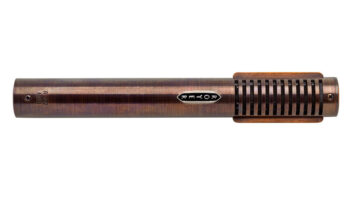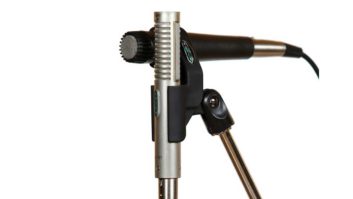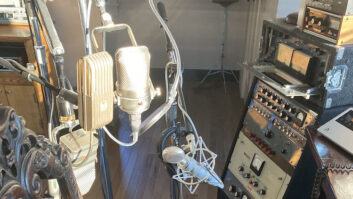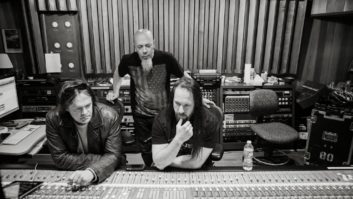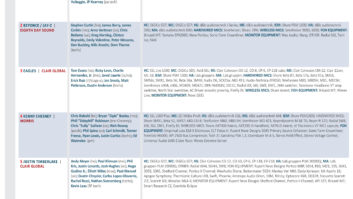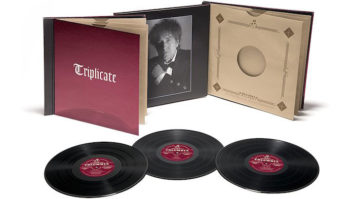Until now, fans of ribbon mics have had to put up with the historic drawbacks of such transducer designs, including low-output level (usually requiring use with a high-gain mic preamp) and compromised tonal performance when used with a low-impedance load. The Royer R-122 ($1,695 list) incorporates a revolutionary design that overcomes these limitations.
The R-122 uses the same ribbon-transducer assembly as the previously released Royer R-121 microphone, but it adds a head-amplifier system that operates on 48-volt phantom power. The new design gives the R-122 several distinct advantages, including 10mv/PA sensitivity (which is on par with condenser mics), uncompromised performance when used with low-impedance and standard-gain mic preamps, and reduced signal loss with long cable runs. Users can forget any concerns they might have about damaging the ribbon element with the unintentional application of phantom power; in fact, the R-122 is the first commercially available ribbon mic that requires phantom power in order to operate.
Interestingly, the R-122’s head amplifier doesn’t amplify the capsule’s signal. The mic’s gain increase is accomplished through the use of a specially designed transformer, which also provides the optimal load for the ribbon element, a feature Royer terms Z-match. The head amp is essentially a buffering device, presenting a high impedance and minimal load to the ribbon element and transformer, and a low-impedance output for your mic preamp.
HAND JIVE
The R-122 is a completely handcrafted, side-address mic that measures 8.5 inches long and 1 inch in diameter. As with all ribbon mics, the polar pattern is bidirectional, or figure-8. The head capsule uses a 2.5-micron-thick aluminum ribbon and rare-earth neodymium magnets.
The sturdy, 10.9-ounce R-122 features a low-carbon steel body rather than brass, because steel offers the superior magnetic shielding that ribbon mics require for low-noise performance. The body comes standard with a burnished, satin-nickel finish, but a matte-black chrome finish is also available. Standard accessories include a spring-loaded mic clip, protective wood case and microphone sock. Optional accessories include the PS-100 ($47.50) and PS-101 ($59) windscreens (the latter featuring a gooseneck) and the AT84 shockmount ($72). You can also order matched mic pairs. The R-122 comes with a generous lifetime warranty to the original owner.
One of the primary goals that Dave Royer had in designing the R-122 was to get the frequency response as flat as possible from 50 to 10k Hz. The mic exhibits a significant, broad dip centered around 15 kHz, due to the offset arrangement of the ribbon element with respect to its front and back damping screens. Royer intentionally positioned the ribbon approximately 3/32 inches from the front damping screen and roughly 3/16 inches from the back damping screen. This arrangement gives the ribbon a farther distance to travel before hitting the back damping screen when subjected to high SPLs at the front of the mic. As a result, the R-122 can handle sound levels in excess of 135dB SPL, very respectable for any mic and especially impressive for a ribbon mic.
But offsetting the ribbon element also causes the aforementioned dip in frequency response at 15 kHz for sounds arriving at the front of the mic. (The mic’s frequency response is stated to be 30 to 15k Hz ±3 dB.) The dip is caused by phase cancellations due to the correlation between the mic’s physical dimensions and wavelengths at high frequencies. That is, frequencies around 15 kHz arrive at the front and rear of the mic element out of phase with respect to each other and tend to cancel.
Dave Royer welcomed the dip at 15 kHz, because it understates the reproduction of high partials on instruments such as horns. The designer’s intention was to create a mic that produces a warm recording of instruments such as brass and electric guitar that can sometimes sound glassy when recorded with condenser mics.
If you wish to mitigate the R-122’s high-frequency dip, then aim the back of the mic at the sound source. An air pocket between the ribbon element and the front damping screen creates a resonance that counteracts the phase-loss effect caused by the mic’s dimensions. This resonance produces a greater high-frequency extension than that achieved by facing the front of the mic at the sound source. In plain English, pointing the back of the mic at the sound source will produce a brighter, more detailed recording than you’ll get by pointing the front of the mic at the source. Practically speaking, it’s great to have two very different tonal responses to choose from with one mic. [Note: As the rear side of a figure-8 mic is out of phase to its front face, reversing phase at the mic pre is required when recording on the R-122’s rear side for in-phase recording. Also, Royer suggests not using the rear side of the R-122 for high SPL recordings, because the ribbon element is being driven toward the closer damping screen when the mic is reversed. — Ed.]
The R-122’s self-noise is conservatively rated to be less than 20 dB, unweighted.
TO THE TEST
Jangling a set of keys about four inches from the R-122 as I walked around the mic, I heard a noticeably greater high-frequency extension and better transient response at the rear of the mic, as expected. In an A/B test with a Neumann U87A condenser mic set to bidirectional mode (i.e., the same polar pattern as the R-122), the R-122’s transient response at the back of the mic sounded at least as good and perhaps a little better than the Neumann’s. The front of the R-122 produced significantly duller results.
My tests also confirmed that the R-122’s off-axis frequency response is very uniform out to at least 70° to either side of the front or rear of the mic. Beyond 70°, the mic’s excellent rejection (as you approach the 90°/270° nulls) makes it difficult to judge the response subjectively.
Next up was an A/B test of the R-122 and the U87A (again, set to bidirectional mode) on male lead vocals. Singing into the front of both mics from a distance of about seven inches, the U87A sounded clearer and the Royer very muffled. The spectral balance produced by singing into the rear of the R-122 was a lot closer to that produced by the same application and setup for the figure-8 U87A. Both mics lacked the clarity and transient response I typically regard as optimal for recording lead vocals (with the U87A in figure-8 mode), although it’s conceivable that the Royer could deliver great results on an overly bright or thin-sounding singer. All things considered, lead vocals are not the primary application that I would choose to use the R-122 for, although the mic’s flat frequency response provides a “clean slate” starting point for adding EQ.
Next up was an A/B comparison between a pair of R-122s and a pair of (cardioid) DPA 4011 small-diaphragm condenser mics, recording acoustic guitar at a distance of six inches in spaced-pair configurations. The 4011s sounded noticeably flatter and exhibited better transient response and a much wider stereo image. However, the R-122s (pointing the front side of the mics at the source) sounded much more soothing and warm compared to the 4011s. Pointing the backside of the R-122s at the guitar resulted in a noticeably improved transient response and an overall brighter tone, but the Royer mics still lacked the clarity and detail produced by the 4011s. For recording warm and full-sounding acoustic guitar tracks with minimal or no accompaniment, the R-122s would be an excellent choice. Where more detail is needed to cut through dense arrangements, I’d probably go with very fast, small-diaphragm condenser mics.
I achieved outstanding results recording a ukulele with two R-122s placed in a Blumlein configuration (with the rear side of each mic facing the source). The performer sang her lead vocals at the same time she played her instrument, so figure-8 mics were needed to achieve the best separation between all three tracks. (I used a Brauner VM1 Klaus Heyne Edition mic in bidirectional mode on the lead vocal, along with the two R-122s on the ukulele.) Not only did the R-122s’ nulls perform admirably here, the mics also provided a nice stereo image and the perfect spectral balance for the ukulele tracks. The instrument sounded very warm and nicely detailed, without being too plucky. In fact, no EQ was necessary during mixdown. One cautionary note: As with all bidirectional mics (ribbon or otherwise), the R-122 used with its stock mic clip tends to pick up mic stand rumble caused by foot-tapping performers, so use of the optional shockmount is recommended.
Perhaps the best applications for the R-122 are recording horns and electric guitars, just what Dave Royer had in mind when he designed the mic. Pointing the front of the mic at a trumpet, the recording sounded well balanced and had plenty of presence, without sounding glassy or brittle. Using the front of the mic on electric guitar cabinet also produced warm and smooth-sounding results. Shaker overdubs sounded smooth and detailed when recorded with the rear side of the mic.
CONCLUSIONS
The R-122 is best used to record instruments where a warm and round tone is sought over detail. It’s not that the R-122’s transient response is particularly slow; it’s fast enough to capture the detail needed for particular applications, yet understated just enough to let the warmth and smoothness of the mic predominate in the overall sound. Because of its unique character, I wouldn’t recommend the R-122 as the one mic to buy for a small studio on a budget. However, larger facilities needing a broad array of tools will find the R-122 very useful for many applications. In short, the R-122 is a high-quality mic with a distinctive sound that should usher it into many a professional mic cabinet.
Royer Labs, 821 North Ford St., Burbank, CA 91505; 818/760-8472; fax 818/760-8864; www.royerlabs.com.
Michael Cooper is a Mix contributing editor and owner of Michael Cooper Recording in beautiful Sisters, Ore.
